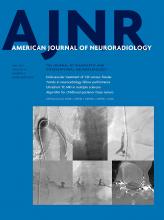In the treatment of tandem stroke, several studies have shown the efficacy and safety of endovascular treatment. However, there are many unanswered questions regarding this treatment strategy including technical aspects as well as peri- and postprocedural antithrombotic management. The extracranial lesion is usually treated by acute stent placement, but balloon angioplasty can be performed as an alternative. Data from the TITAN Registry and German Stroke Registry support that acute stent placement is associated with a better clinical outcome compared with balloon angioplasty in treating extracranial lesions.1,2 The main disadvantage of acute stent placement is the potential risk for stent thrombosis with re-occlusion of the internal carotid artery.
In the current issue of AJNR, Pop et al3 report 2 important findings regarding acute stent placement in tandem lesions. First, the rate of stent thrombosis was not insignificant, with a frequency of 14.5%. Although data from large registries regarding stent patency are limited, other authors report the thrombosis risk after acute stent placement as up to 45%.4 The second important finding was that the highest risk of stent thrombosis was observed during the first 24 hours, and stent thrombosis beyond the first day was rare. Both findings suggest that the current acute antithrombotic regimen is not appropriate for preventing acute stent thrombosis.
The major questions that arise are: 1) Can we avoid acute stent thrombosis? 2) Can the acute antithrombotic regimen be improved? and 3) Can we be more aggressive with the antithrombotic medication in the acute phase? A more aggressive scheme is not without risks, as additional antithrombotic agents may increase the risk of intracerebral hemorrhagic complications, which is the major concern in the endovascular treatment of acute stroke. Therefore, properly calibrating the acute antithrombotic regimen in tandem stroke remains an important challenge.
There are heterogeneous antithrombotic regimens in use by various interventionalists and centers, which limits our complete understanding of this topic. We do not know which agents and what dosing should be applied in the acute setting. What we do know is that an antiplatelet agent is necessary for peri-interventional care to avoid stent occlusion. Platelets are now known to have a pivotal role in thrombosis and inflammation after vessel injury.5 Some patients receive antiplatelet agents with their prestroke medication. These patients are likely to be at low risk of stent thrombosis, and therefore, an aggressive antiplatelet strategy could be avoided. In the remaining patients, acute peri-interventional antiplatelet agents should be applied to prevent stent thrombosis. Agents that can be used include intravenous aspirin, clopidogrel, ticagrelor, and glycoprotein IIb/IIIa inhibitors (GPIs), or the new drug, cangrelor. Aspirin and clopidogrel inhibit 2 vital pathways of platelet activation; however, this effect does not occur immediately after usage. In contrast, GPIs directly block the most abundant receptor on the platelet surface and are highly effective. Although, if given at full dosage, a substantially increased risk of bleeding is known to occur with GPIs.6
The high rate of acute stent thrombosis in treatment of tandem lesions stroke highlights the challenge of acute antiplatelet therapy. Future studies should focus on establishing an optimal antithrombotic regimen.
References
- © 2021 by American Journal of Neuroradiology












